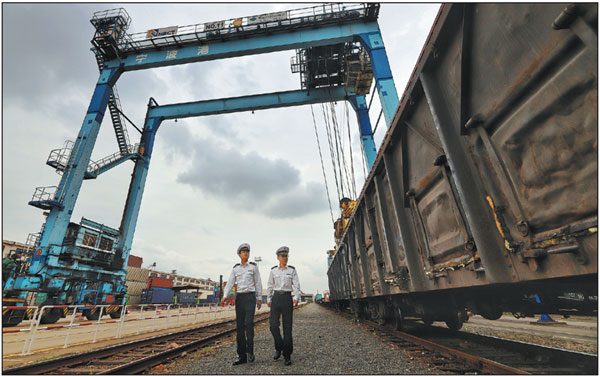Top customs tech takes trade to a new level

Officials of Ningbo Customs in Zhejiang province inspect a rail-sea combined transportation site. [Photo/Gao Xuefeng For China Daily]
City of Ningbo plays key role in upping exchanges with enterprises in Central and Eastern Europe.
Ningbo Customs, located in Zhejiang province, is pushing ahead to increase trade between China and Central and Eastern European countries.
As one of China's busiest ports, Ningbo Port has played a prominent role in deepening cooperation between China and Central and Eastern European countries.
In 2018, the trade volume between Ningbo and CEEC reached 24.36 billion yuan ($3.52 billion), a year-on-year increase of 23.1 percent, and 10.2 percentage points higher than the city's overall growth rate.
Ningbo's export volume was 21.05 billion yuan, an increase of 22 percent, and the import volume was 3.31 billion yuan, an increase of 30.5 percent.
In the first four months of this year, trade volume between Ningbo and CEEC hit 7.88 billion yuan, an increase of 7.6 percent over the same period last year.
In response to the increasing trade between China and CEEC, Ningbo Customs has taken steps to provide more effective and efficient services and procedures.
One such measure is smart inspection, which involves the usage and archiving of digital images of trade products and a large-scale product information filing system.
The imaging system collects images of common import and export commodities at Ningbo Port and carries out automated image analysis via image recognition technology.
So far, it has collected 400,000 images to store as its basic image library.
The image filing system records commodity data and other product information including that of traders.
This technology means that processing at the port can be carried out with much greater ease than previously.
In the first four months this year, 147 enterprises used the systems registering more than 1,200 commodities. Smart inspection can save traders up to 50 percent in custom processing time, Ningbo Customs said.
"Thanks to such machine inspection launched by Ningbo Customs, our goods, which are already on file, can be given priority for inspection," said an executive surnamed Huang from local company Ningbo Far East Lighting.
The majority of goods coming into China from CEEC are declared at Ningbo Port.
"The images of our goods have been added into the smart machine inspection system, and they now provide auxiliary reference for customs inspection, accelerating the clearance speed of the goods and reduce our costs," Huang said.
Ningbo Customs is also using internet of things technology and cloud computing to monitor goods, especially those in transit.
The port uses a smart security lock system which collects real-time information on the status of goods using satellite positioning during the entire transportation process.
The use of such technology, together with online declaration and automatic checks and simplified customs procedures, has greatly improved convenience for all parties, an official from Ningbo Customs said.
In May, Ningbo Customs signed a strategic cooperation agreement with the Ningbo branch of China Mobile to use 5G technology in customs supervision.
In the future, 5G and augmented reality technology will further improve customs efficiency.
Ningbo Customs said it will step up its efforts in customs supervision and promote the development of trade between Ningbo and CEEC.



 Print
Print Mail
Mail
